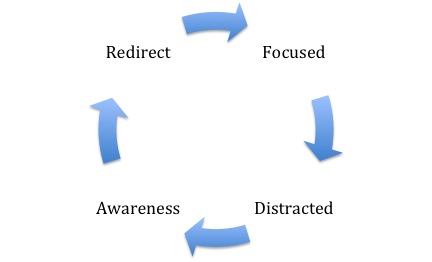I’m not saying that it is a cure-all, but mindfulness seems to help a lot of people with a lot of different things. Journals in every discipline lately are printing articles about how mindfulness could be a really promising addition to their field. I’ve come across research talking about how mindfulness can reduce stress, pain, anxiety, make people more productive, increase happiness, and even reduce heart disease!
If mindfulness were a pill, you can bet it would be a best seller.
But the thing is, mindfulness is that simple, it’s just not that easy. Sure, it sounds easy – just observe the present moment. Should be the easiest thing in the world, right?
 So. Deceptively. Simple.
So. Deceptively. Simple.
And it can be so discouraging when you realize it isn’t as easy as it sounds.
If you’re anything like me, it’s really hard to keep your mind in the present moment. It takes constant diligence. When I try to meditate, I spin around the mindfulness circle at a dizzying pace.
And that’s OK.
It’s just a part of the process. The point of mindfulness practice isn’t to stay in the present moment the whole time. It’s to become more aware of where your mind goes and to learn how to redirect it when you need to. For a refresher on the mindfulness process and the mindfulness circle, click here.
I start out focused on my breath, but my mind quickly gets distracted. It’s amazing what becomes interesting when I am trying to meditate. My mind wanders from writing my grocery list to trying to sort out family dynamics. The topic really makes no difference – it all takes me out of the present moment. The bottom line is that it is really hard to stay focused in the present moment.
Which is why we need to practice.
The ability to stay focused in the present moment isn’t developed overnight. It takes time and practice to build it.
We’re human. We think. We think all of the time.
 Ask me to just SIT with something, and not try to DO anything about it, and my mind will leap around like a crazed monkey in small cage. It frantically searches for something else to be doing, something else to figure out. All this when all I want is to ask it to slow down, just for a few moments, and focus on just one thing at a time.
Ask me to just SIT with something, and not try to DO anything about it, and my mind will leap around like a crazed monkey in small cage. It frantically searches for something else to be doing, something else to figure out. All this when all I want is to ask it to slow down, just for a few moments, and focus on just one thing at a time.
It sounds like such a small task… But it can be overwhelmingly difficult.
It seems like such a simple task… But it can be infinitely complex.
So we need to practice it. And like many things in our brains, if you don’t use it, you lose it. Your brain actually rewires itself based on how you focus your attention. It builds itself to support your apparent interests,based on what you choose to pay attention to. This process is called neurogenesis.
If your brain builds itself so it can support your intentions, then doesn’t it make sense that you need to be very conscious about where you place your attention?
With practice, it can become easier to make conscious choices about what you think about and what you do. In my next post, I will take you through a step-by-step process to help you develop a regular mindfulness practice that is sustainable and tailored to you.
By the way, if you’re interested in staying up-to-date with the current research on mindfulness, check out the Mindfulness Research Guide. They publish a great monthly newsletter highlighting recent research on mindfulness.





